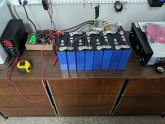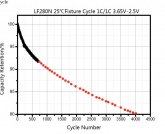I have 8 new aluminum case 120ah lifepo4 cells for a 24v system that I bought off Aliexpress. (Same seller that Will recommended for another size) They arrived at 3.25v. I paralleled all 8 batteries and put them on a charger a 3.65v with the goal of top balancing before performing a capacity test. After waiting a week I put them in series and charged the pack to about 28v. After the charger finished I swapped them back to parallel at 3.65v for about a day.
The pack was still charging at 1.2 amps when I removed the charger. I think my power supply voltage reading may be inaccurate as each cell was showing about 3.67v. There's a little swelling on most cells and one cell as wide as 1/8". The pack in series read 29.3v. I read something the other day after the fact that said I should not charge such a large pack at such a lower current because of possible over charging which is what I unfortunately did.
I performed a slow capacity test pulling 80 to 100 watts until the BMS cut off at 2.5v. I did not add the BMS until after the above balancing. 1 cell reached 2.5v and the rest were about 3v when the battery cut off. The cell at 2.5v is the cell 1/8" swollen. With that said, my capacity test resulted in 122ah. I've had the pack back on the charger for about 50 minutes and all cells are 3.24v and rising with only a 0.008v difference. (BMS still attached) The power supply/charger is CC/CV.
As someone very new to DIY battery building and with a plan to install the battery in my RV, should I be concerned about the 1 cell? I've attached a picture of the cells and some of my gear. The left 2 most batteries are the most swollen with the low 2.5v reading being the far left/positive terminal. Thank you for the input!
EDIT: Here's a high quality image upload.
The pack was still charging at 1.2 amps when I removed the charger. I think my power supply voltage reading may be inaccurate as each cell was showing about 3.67v. There's a little swelling on most cells and one cell as wide as 1/8". The pack in series read 29.3v. I read something the other day after the fact that said I should not charge such a large pack at such a lower current because of possible over charging which is what I unfortunately did.
I performed a slow capacity test pulling 80 to 100 watts until the BMS cut off at 2.5v. I did not add the BMS until after the above balancing. 1 cell reached 2.5v and the rest were about 3v when the battery cut off. The cell at 2.5v is the cell 1/8" swollen. With that said, my capacity test resulted in 122ah. I've had the pack back on the charger for about 50 minutes and all cells are 3.24v and rising with only a 0.008v difference. (BMS still attached) The power supply/charger is CC/CV.
As someone very new to DIY battery building and with a plan to install the battery in my RV, should I be concerned about the 1 cell? I've attached a picture of the cells and some of my gear. The left 2 most batteries are the most swollen with the low 2.5v reading being the far left/positive terminal. Thank you for the input!
EDIT: Here's a high quality image upload.
https://i.imgur.com/iBhcxXm.jpg



